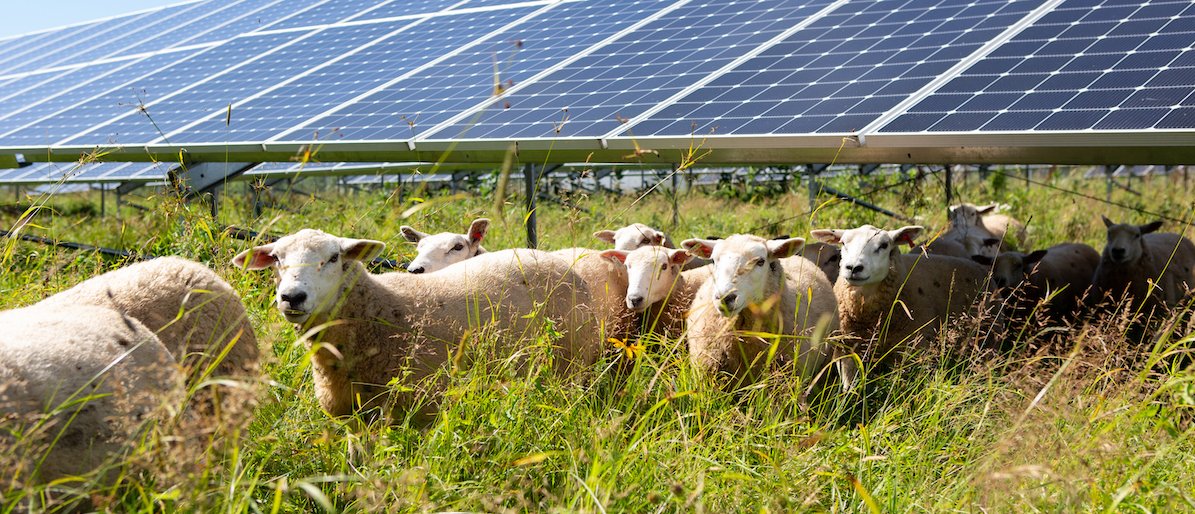From pv magazine USA
The American Solar Grazing Association has launched a two-year project to collect and analyze data on the agricultural, economic, and environmental impacts of co-locating agricultural enterprises such as commercial beekeeping and sheep grazing on photovoltaic sites.
Tthe New York State Energy Research and Development Authority (NYSERDA) is backing the project. It has provided a $198,000 research grant through its Environmental Research Program. NYSERDA is joined in supporting the project by the New England Division of American Farmland Trust and Juniper Economic Consulting.
The study will collect data from solar installation sites co-located with beekeepers and/or grazing herds, as well as conventional, standalone operations for comparison. Lexie Hain, the executive director of the American Solar Grazing Association, said that the researchers are looking for most sites to be grazed.
Data will be collected during the 2022 and 2023 grazing seasons. The study will aim to address questions regarding the quality and profitability of farm products from solar sites, trends in soil health on agriculturally managed solar sites, and the benefits to farmers of working with the solar industry.
The full list of solar sites to be studied has yet to be finalized, but a number of sites owned and operated by Nexamp, a leading developer of community solar in New York State, will be included. Two sites will be grazed with sheep owned by a family-owned grazing operation in Orleans, New York.
 Nexamp is looking to quadruple the number of solar sites being grazed in the 2021 season. The company said that sheep are less likely to cause damage to photovoltaic equipment than traditional vegetation management.
Nexamp is looking to quadruple the number of solar sites being grazed in the 2021 season. The company said that sheep are less likely to cause damage to photovoltaic equipment than traditional vegetation management.
Popular content
The American Solar Grazing Association is still looking for solar participants in the study, however. It will accept applications until the end of August.
Beekeeper Mike Kiernan of Vermont-based Bee The Change will also take part in the study. Kiernen said he sees solar sites as a vital habitat for honey bees, as well as the hundreds of species of native bees, butterflies, and wasps that collectively transform blossoms into vegetables and field crops.
And while the project is funded by NYSERDA and is largely confined to New York and adjacent states, Hain said that the findings should be useful to farmers and solar developers across the country.
The work builds on “Grazing Sheep on Solar Sites in New York State: Opportunities and Challenges,” a 2018 pilot study by Cornell University. The study was preliminary in nature and the solar industry has undergone significant change since 2018, but the basics still hold true. Sheep can provide vegetation management for solar farms, the vegetation that the sheep ingest is healthy for them, and economic opportunity exists for farmers who want to develop additional revenue streams.
As Hain describes it, the newly launched study aims to evolve the idea from a niche business opportunity to a legitimate industry adjacent to solar. Researchers know that sheep can be symbiotic to solar installations; now they want to grow the scale of that relationship and develop diverse, credible testimony both from solar project owners and the grazers and beekeepers involved.
This content is protected by copyright and may not be reused. If you want to cooperate with us and would like to reuse some of our content, please contact: editors@pv-magazine.com.



2 comments
By submitting this form you agree to pv magazine using your data for the purposes of publishing your comment.
Your personal data will only be disclosed or otherwise transmitted to third parties for the purposes of spam filtering or if this is necessary for technical maintenance of the website. Any other transfer to third parties will not take place unless this is justified on the basis of applicable data protection regulations or if pv magazine is legally obliged to do so.
You may revoke this consent at any time with effect for the future, in which case your personal data will be deleted immediately. Otherwise, your data will be deleted if pv magazine has processed your request or the purpose of data storage is fulfilled.
Further information on data privacy can be found in our Data Protection Policy.